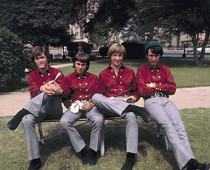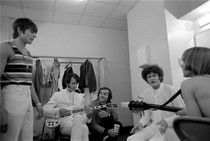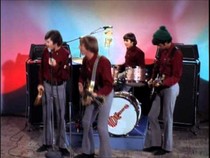Hey, hey, it’s The Monkees
 Given the force with which The Beatles exploded in America, it was fairly inevitable that a flurry of entrepreneurs would attempt to replicate the success of the Fab Four. Starting in 1964, the marketplace became cluttered with sub-par attempts to jump on the Beatle bandwagon: record companies pressed countless records from indistinguishable bands as long as they dressed in suits, sported mop-top hairdos and bandied about buzzwords like “fab” and “gear”. By and large, the attempts of the American marketplace to find “the next Beatles” failed, simply because there was always an air of condescension to their tactics; they glossed over the integrity and subtlety of the Beatles and underestimated the ability of the record-buying public to discern the difference between the real deal and a pale imitation. In short, they didn’t get it.
Given the force with which The Beatles exploded in America, it was fairly inevitable that a flurry of entrepreneurs would attempt to replicate the success of the Fab Four. Starting in 1964, the marketplace became cluttered with sub-par attempts to jump on the Beatle bandwagon: record companies pressed countless records from indistinguishable bands as long as they dressed in suits, sported mop-top hairdos and bandied about buzzwords like “fab” and “gear”. By and large, the attempts of the American marketplace to find “the next Beatles” failed, simply because there was always an air of condescension to their tactics; they glossed over the integrity and subtlety of the Beatles and underestimated the ability of the record-buying public to discern the difference between the real deal and a pale imitation. In short, they didn’t get it.
Bert Schneider and Bob Rafelson got it, though. Schneider (whose father was the president of Columbia Pictures) and Rafelson (who had previously directed Hootenanny for ABC) recognized that “Hollywood has a thing for making pictures that talk down to young people” and, sensing the need in the market, pitched a television show to Columbia about a young rock band living in a beach house in California. The atmosphere would be loosely based on that of The Beatles’ movies A Hard Day’s Night and Help, and there would be a new song premiered every week. Columbia agreed to the premise, and the duo placed an open casting call in Variety magazine looking for “4 insane boys, aged 17-21.” Among the 437 hopefuls who tried out were Harry Nilsson (later a highly successful singer), Danny Hutton (later of Three Dog Night), Rodney Bingenheimer (later a highly successful DJ), and – allegedly – Charles Manson (later to have a song recorded by the Beach Boys, among other activities). However, the disparate quartet that were chosen were Micky Dolenz, a former child actor and lead singer of a garage band called The Missing Links; Michael Nesmith, a country singer-songwriter who had a song covered by The Paul Butterfield Blues Band; Davy Jones, a young actor from Manchester who had performed Oliver on Broadway (and on the Ed Sullivan Show immediately before The Beatles’ debut appearance); and Peter Tork, a folk singer-songwriter from Greenwich Village who had been tipped off to the auditions by his friend Stephen Stills (who had also auditioned but was rejected for poor dental hygiene). The group was dubbed The Monkees.
 However, the disparity of the assembled cast’s backgrounds did not mix well. Nesmith and Tork were constantly arguing about the group’s musical direction, and Dolenz and Jones were unable to play drums and guitar (their assigned instruments). However, they had great voices: Jones had the kind of voice that made teenage girls swoon, while Dolenz had a terrific voice equally adept at raucous rock and soulful ballads. As Schneider and Rafelson worked on the fast-paced and clever episodes, they hired Don Kirshner (president of the music division of Columbia Pictures) to take care of the show’s musical aspect. Kirshner’s publishing company, Aldon Music, published Brill Building songwriters like Goffin and King, Sedaka and Greenfield, and Mann and Weil. With such talented songwriters and an excellent team of session musicians put together by Tommy Boyce and Bobby Hart, the show gained had the musical muscle essential to give it integrity and staying power. The Monkees themselves were called upon only to provide vocals for completed backing tracks. With their hectic filming schedule and inability to produce a coherent musical vision of their own, the band begrudgingly accepted these terms.
However, the disparity of the assembled cast’s backgrounds did not mix well. Nesmith and Tork were constantly arguing about the group’s musical direction, and Dolenz and Jones were unable to play drums and guitar (their assigned instruments). However, they had great voices: Jones had the kind of voice that made teenage girls swoon, while Dolenz had a terrific voice equally adept at raucous rock and soulful ballads. As Schneider and Rafelson worked on the fast-paced and clever episodes, they hired Don Kirshner (president of the music division of Columbia Pictures) to take care of the show’s musical aspect. Kirshner’s publishing company, Aldon Music, published Brill Building songwriters like Goffin and King, Sedaka and Greenfield, and Mann and Weil. With such talented songwriters and an excellent team of session musicians put together by Tommy Boyce and Bobby Hart, the show gained had the musical muscle essential to give it integrity and staying power. The Monkees themselves were called upon only to provide vocals for completed backing tracks. With their hectic filming schedule and inability to produce a coherent musical vision of their own, the band begrudgingly accepted these terms.
 On September 12, 1966, the first episode of The Monkees aired on NBC. The show was initially met with some resistance; some affiliates did not want to take a chance on airing a show about 4 young rock musicians living together with no parental supervision. As Dolenz later wrote, “It’s hard to imagine now, but in 1966 long hair was synonymous with everything from radical anti-American subversiveness to crimes against nature. Suddenly, every Monday night, right in the middle of our living rooms, in bounced the Monkees four harmless, long-haired weirdos who were not only honest, virtuous, clean, and wholesome – they were funny! Look, Mom,’ said the kids in Peoria, the Monkees have long hair, and they don’t rape children and sodomize animals.'” The theme song of the show highlighted this philosophy with the line “we’re too busy singing to put anybody down.” The show portrayed 4 independent, devil-may-care kids playing music, romping about, and occasionally helping old ladies cross the street or helping to save a small circus from folding. The Monkees won the hearts of Middle America in this way, but the shows were clever enough to maintain their integrity with the young. “The four young Monkees weren’t fooled for a moment,” Timothy Leary wrote. “They went along with the system but didn’t buy it – the Monkees use the new energies to sing the new songs and to pass on the new message.”
On September 12, 1966, the first episode of The Monkees aired on NBC. The show was initially met with some resistance; some affiliates did not want to take a chance on airing a show about 4 young rock musicians living together with no parental supervision. As Dolenz later wrote, “It’s hard to imagine now, but in 1966 long hair was synonymous with everything from radical anti-American subversiveness to crimes against nature. Suddenly, every Monday night, right in the middle of our living rooms, in bounced the Monkees four harmless, long-haired weirdos who were not only honest, virtuous, clean, and wholesome – they were funny! Look, Mom,’ said the kids in Peoria, the Monkees have long hair, and they don’t rape children and sodomize animals.'” The theme song of the show highlighted this philosophy with the line “we’re too busy singing to put anybody down.” The show portrayed 4 independent, devil-may-care kids playing music, romping about, and occasionally helping old ladies cross the street or helping to save a small circus from folding. The Monkees won the hearts of Middle America in this way, but the shows were clever enough to maintain their integrity with the young. “The four young Monkees weren’t fooled for a moment,” Timothy Leary wrote. “They went along with the system but didn’t buy it – the Monkees use the new energies to sing the new songs and to pass on the new message.”
The music, originally intended to be released simply as a tie-in to the television show (like the charting theme songs to Gidget, Davy Crocket and Rawhide), was becoming immensely popular in its own right. By November, their first single, “Last Train To Clarksville” and their self-titled debut album were number one on their respective Billboard charts. That December, a double A-sided single of the Neil Diamond-penned bubblegum classic “I’m A Believer” and Boyce and Hart’s garage anthem (later covered by the Sex Pistols) “(I’m Not Your) Steppin’ Stone” sold over a million copies in advance. Monkees records began outselling ones by the Beatles and the Stones. The group made their live debut in Honolulu after undertaking extensive rehearsals to get four musicians who had never played together before (including Dolenz, who had recently taken a month-long crash course in drumming) to approximate the sound of LA’s top session musicians. Although the now-expected screaming of teenage girls meant that nobody in the Honolulu International Center Arena heard a note of what was being played, The Monkees had become a respectable garage band in less than a year.
Fresh with optimism, The Monkees expected to start recording as a band. However, Don Kirshner was reluctant to have his considerable musical power usurped by some kids who had only been playing together for a few months. “What we asked for was to be allowed to be the studio musicians on our own records,” Tork recalled. “We did not ask for creative control, we did not ask to be the producers, we did not ask to replace Kirshner.” That January, after some contentious debates (wherein Nesmith, by all accounts, punched a hole in the wall of the Beverly Hills hotel and told Kirshner “that could have been your face”), they struck a compromise where The Monkees would record the b-side of their next single. Kirshner, doubtful of the band’s abilities, went ahead and rush-released a single with session musicians performing on both sides. Nesmith responded by conducting an interview with the Saturday Evening Post where he revealed “the music has nothing to do with us. Tell the world we’re synthetic because, damn it, we are.” Before Kirshner knew it, he was fired as the musical director, and The Monkees went in the studio to record their first album as a band (their third album overall), “Headquarters.”
Nesmith’s proclamations had earned them derision in certain circles, but the records kept selling and the TV show was renewed for another season. During a tour of London, The Beatles spoke highly of The Monkees. John Lennon said “The Monkees are the greatest comic talent since the Marx Brothers” and invited them to observe some recording sessions for “Sgt. Pepper’s Lonely Hearts Club Band” (Nesmith can be seen in the promotional video for “A Day In The Life” talking to Lennon). When “Headquarters” was released in May of 1967, critics and fellow musicians were impressed by the musicianship, from Nesmith’s jangly 12-string and pedal steel guitar work to Tork’s baroque harpsichord ornamentation. With this newfound respect, the band began soaking up the vibes of the Summer of Love. Dolenz and Tork went to the Monterey Pop Festival and, impressed with The Jimi Hendrix Experience, invited the band to be the opening act for their summer tour. Hendrix’s guitar pyrotechnics and blatantly sexual stage presence were not appreciated by the teenage girls that comprised the core audience for The Monkees, and Hendrix left the tour after 5 shows. Hits such as “Pleasant Valley Sunday” and “Daydream Believer” solidified their commercial standing, but their albums contained much experimentation by Nesmith (who was pioneering country-rock before similar efforts by The Byrds and The Flying Burrito Brothers) and Dolenz (whose Moog synthesizer work on “Daily Nightly” is the first use of the instrument on a pop record). The second season of the TV series also got considerably more experimental, with hip dialogue that broke “the fourth wall” and guest appearances from the likes of Tim Buckley and Frank Zappa. Slowly but surely, The Monkees were proving to naysayers that they had the talent and the hipness to rub shoulders with the bands with whom they shared the top 10.
The final frontier to be conquered was cinema. In 1968, Bob Rafelson introduced the band to a young actor and writer named Jack Nicholson. Nicholson’s fresh ideas inspired the band to make a film that would expose their own “manufactured image with no philosophies” (as the movie’s theme put it) and replace their teenybopper image with a new, underground persona. After a weekend writing session involving the four Monkees and Nicholson rambling into a tape recorder (with the aid of a nearly unlimited supply of marijuana), Rafelson and Nicholson whipped it into shape as a film script titled “Head.” So impressed were The Monkees by the script that they did not seek out a third season of their television show. Unfortunately, while the movie succeeded in destroying their teenybopper image, the film’s stoned atmosphere offered no strong alternate personality of the group. A mixture of the band careening in and out of satires on various movie genres, concert performances, newsreel footage from Vietnam, and scenes involving the band being stuck in a black box with an Indian mystic, the movie confused nearly everyone who saw it. As Tork put it, “the heads didn’t want to see a Monkees movie, and the teenyboppers didn’t want to see a head movie. So we got nobody.” Although it has since been hailed as a cult film, a triumphant artistic reaction to the confusion and violence of 1968 (almost like a cinematic version of the White Album), it sank without a trace along with its single, Goffin and King’s psychedelic masterpiece “Porpoise Song.”
The band returned to TV with a special called “33 and 1/3rd Revolutions Per Monkee.” Another attempt to shatter the band’s mythology, the special had an even less cohesive plot, and despite interesting musical performances (like a 50’s rock medley with Jerry Lee Lewis, Fats Domino and Little Richard all playing pianos stacked atop one another, or a 10 minute jam on Nesmith’s “Listen To The Band” with the Buddy Miles Express), it too attracted a very small audience. (This was undoubtedly fueled by NBC’s decision to air the special at the same time as the 1969 Academy Awards.) Tork, frustrated with the sudden end to the group’s momentum and the fact that the band had again started using session musicians on their albums, quit immediately after the special aired. Two more unsuccessful Monkees albums were made as a trio, which were in essence collections of solo tracks by Dolenz, Jones and Nesmith. After Nesmith jumped ship, Dolenz and Jones made a contractual obligation album called “Changes” and pulled the plug on the Monkees enterprise.
Following the group’s split, the members tried musical solo careers with varying degrees of success. Tork and Dolenz’s solo singles were roundly ignored, and they turned to other endeavors (becoming schoolteachers and television directors, respectively). Jones had a few successful bubblegum singles and a memorable guest appearance on The Brady Bunch. Nesmith, however, surpassed all expectations by becoming a rock Renaissance man, launching into a string of interesting solo albums that ran the gamut from country-rock to slick dance rock to what could be considered a precursor to new age music. In the early 1980’s, he began directing elaborate music videos for his songs and, after a few successful television programs and home videos, he sold the idea for a music video network to Warner Amex, who realized the idea as MTV.
MTV, sensing The Monkees’ importance as the first band who successfully married music to video (the television show has some of the first examples of “music videos”), began airing reruns of the show, leading to interest in a reunion tour in 1986. Although Nesmith opted out of the tour, the reunited Monkees became the top-drawing concert act of the year. In 1996, Nesmith joined his fellow bandmates and produced an album called “Justus,” which was the first Monkees album to be entirely written, performed, and produced by Micky, Mike, Peter and Davy. The release was followed by a television special written by Nesmith where The Monkees are revealed to be still living and playing together in the same California beach house – in an alternate universe where television shows are never canceled.
Whereas other, less canny, attempts by American executives to create a band that appealed to the youth of the nation are now nothing but kitschy period pieces, the continued success of the show in reruns and the band in oldies tours speaks to the integrity of the project and the indisputable quality of the music. The Monkees are an anomaly in rock: the manufactured group who was able to become a creative entity all their own. “My notion is that Rafelson and Schneider had what I’m fond of calling a Gepetto Complex,'” Tork mused. “They actually did want to see their little puppets become real live boys. We had Pinocchio Complexes. We wanted to be real live boys, too.”
via Hey, hey, it’s The Monkees – Chicago Music | Examiner.com.
 Follow us
Follow us Join us
Join us


